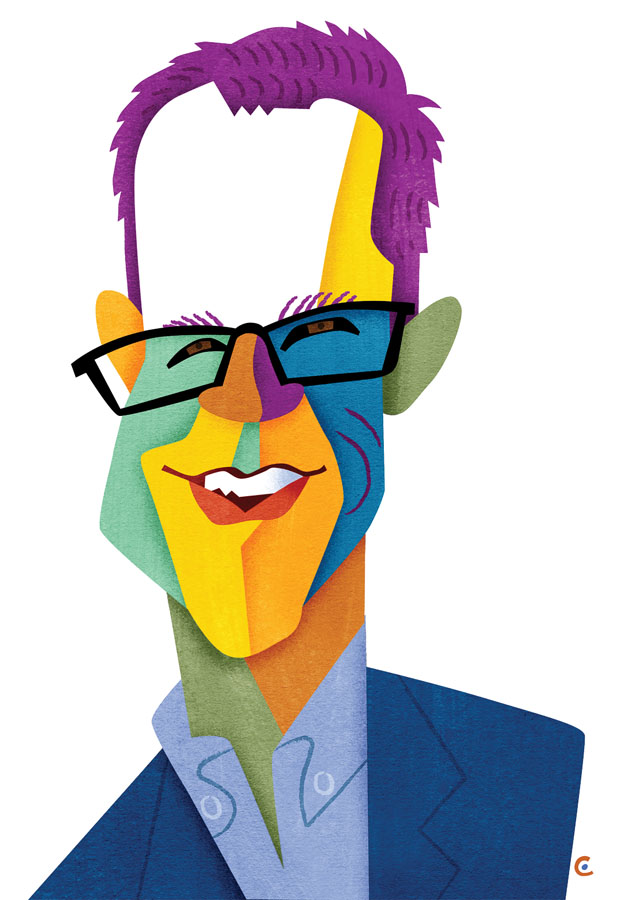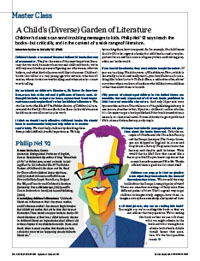Master Class
 (Photo: Illustration by David Cowles for Rochester Review)
(Photo: Illustration by David Cowles for Rochester Review)Philip Nel ’92
Home: Manhattan, Kansas
University Distinguished Professor of English, Kansas State University; author of blog “Nine Kinds of Pie” at Philnel.com, as well as books including Was the Cat in the Hat Black? The Hidden Racism of Children’s Literature and the Need for Diverse Books (Oxford University Press, 2017); Crockett Johnson and Ruth Krauss: How an Unlikely Couple Found Love, Dodged the FBI, and Transformed Children’s Literature (University Press of Mississippi, 2012); and Dr. Seuss: An American Icon (Continuum Publishing, 2004).
On studying children’s literature: “Children’s literature is the reason that I became a reader, and it’s the reason that I became an English major. But I didn’t yet realize that at the time that I was at Rochester. There wasn’t an opportunity to study children’s literature at the time. I didn’t take any classes in children’s literature in graduate school either. I did write a chapter of my dissertation on Dr. Seuss. And that’s when I came to realize that there’s a whole scholarly conversation happening about children’s literature.”
Children’s books are some of the most influential books that any of us encounter. They’re also some of the most important literature that we read, because when we read children’s books, we’re still very much in the process of figuring out who we are, what we believe, and what kind of person we’d like to become. Children’s books also tell us at a very young age who matters, who doesn’t matter, whose stories are worth telling, and whose stories are not worth telling.
My early book on children’s literature, Dr. Seuss: An American Icon, was a look at the cultural significance of Seuss’s work. Although it includes a chapter on Seuss, my new book is on the pervasiveness and complexity of racism in children’s literature. Was the Cat in the Hat Black? The Hidden Racism of Children’s Literature and the Need for Diverse Books has Seuss in the title because he did racist as well as anti-racist work
I think we should teach offensive children’s books. We should learn to read uncomfortably and help children to read uncomfortably. We don’t help children by shielding them from painful, difficult, hurtful experiences. We help by teaching them how to respond. So, for example, if a child learns that it’s OK to be angry at a book, that child has learned a very important lesson and has a sense of agency when confronting prejudice out in the world.
If you teach these books, they must only be taught in context. If you are teaching The Adventures of Huckleberry Finn—which is deservedly a classic and really racist—you should also teach something like Julius Lester’s To Be A Slave, a collection of ex-slaves’ narratives where we learn of mothers who kill their own children rather than allow them to be sold.
Fifty percent of school-aged children in the United States are nonwhite. But only 22 percent of children’s books published in 2016 featured nonwhite characters. And only 13 percent were by nonwhite authors. The whiteness of the publishing industry is one reason. Another is that, if you’re a children’s author of color, it’s a lot easier to get a book published if that book is nonfiction, a memoir, or a historical novel. It’s much harder to get it published if it’s science fiction, fantasy, or dystopia.
It’s important to invite young people to ask questions about the books they read. Take the example of Charlie and the Chocolate Factory and the Oompa Loompas. The Oompa Loompas are shipped to England in crates and they live in a factory. They never leave that factory, and they’re paid in beans. What would that be like? Does that sound like a fun way to live? Do you know any stores that accept beans for payment? Has Mr. Wonka offered them a good deal or a bad deal?
Children can engage in the imaginative work of putting themselves in the shoes of the various characters. What would the story be like from the Oompa Loompa’s point of view? There are countless retellings of fairy tales from different points of view. That’s a great way to get children to imaginatively engage—have them reimagine a story from somebody else’s point of view.
A child might ask, why are we reading this book? You might say we’re reading this book so that we can address that very question. We’re reading this book so that we can talk about what we might admire in the book and what we might not admire in the book. Adults should honor that question. It’s the best question to ask.

